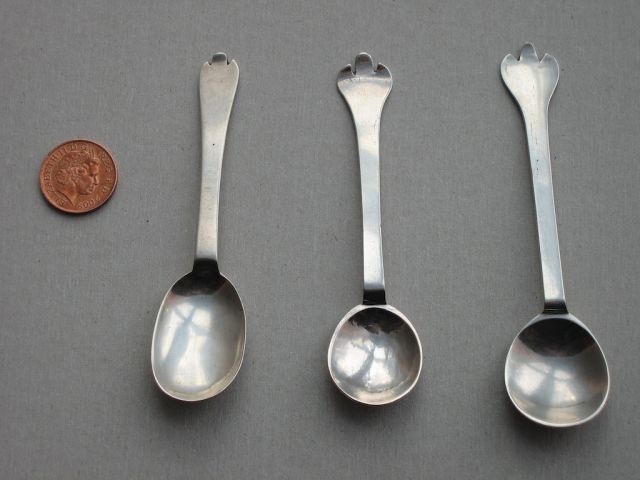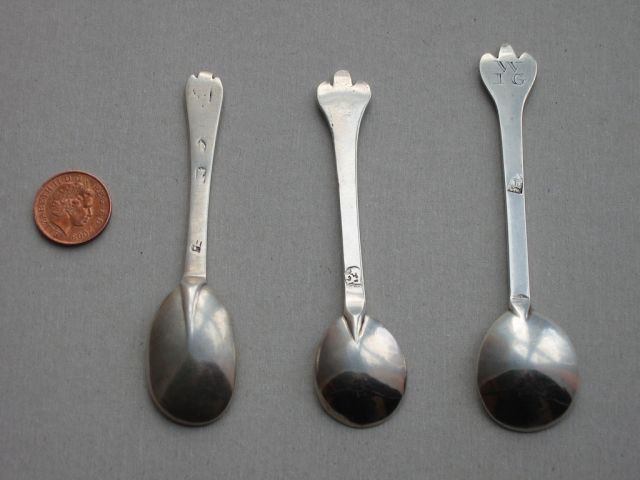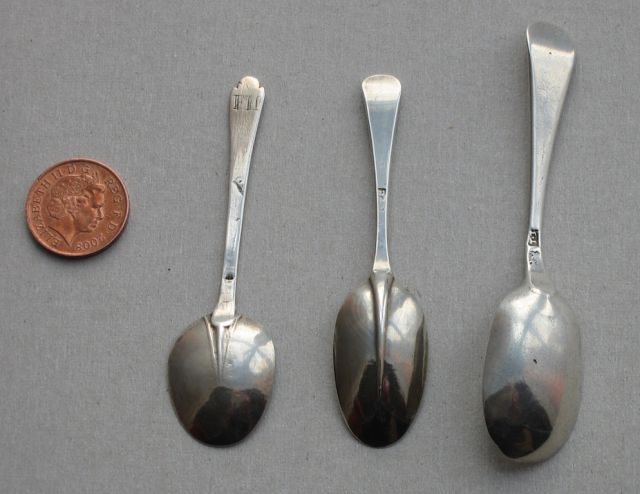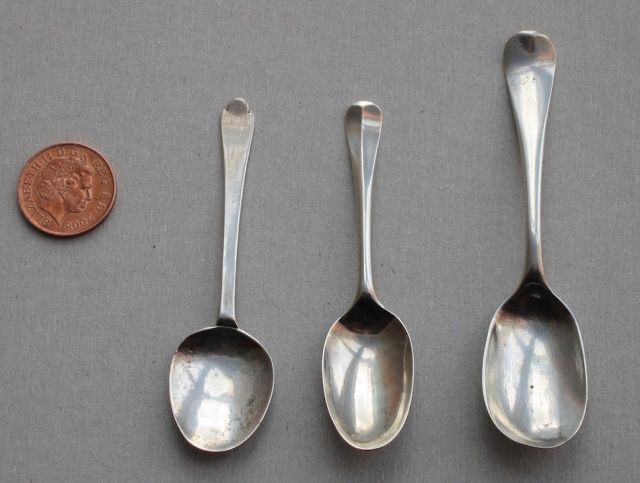|
|
In this Forum we discuss the silver of the United Kingdom, as well as British Colonial silver and Old Sheffield Plate. Past British - Irish Sterling topics/threads worth a look. |
|
|
| How to Post Photos | Want to be a Moderator? |
|
|
In this Forum we discuss the silver of the United Kingdom, as well as British Colonial silver and Old Sheffield Plate. Past British - Irish Sterling topics/threads worth a look. |
|
|
| How to Post Photos | Want to be a Moderator? |

|
 SMP Silver Salon Forums SMP Silver Salon Forums
  British / Irish Sterling British / Irish Sterling
  Specialised Spoons Specialised Spoons
|
| next newest topic | next oldest topic |
| Author | Topic: Specialised Spoons |
|
agphile Posts: 798 |
  
I thought I’d dig out another little subset of spoons to share. It is not exactly a coherent group but the broad heading of specialised spoons might cover it. I’ll start with some trefid condiment spoons.   From the right they are by: Thomas Allen, London c.1680 (maker’s mark only), 4¼ inches long. Francis Garthorne, London c. 1680 (maker’s mark only), 3¾ inches long. Isaac Davenport, London 1700-1711 (fully marked, but date letter too worn to date precisely), 3¾ inches long. However, there is a problem with the Davenport spoon. It is a fake, one of many castings made from a genuine original spoon. A group of six are illustrated in Ian Pickford’s “Silver Flatware”. It is the identical placing of the marks and inscription on each spoon that gives them away. From time to time I notice others being offered for sale, often by dealers who should know better. I keep this one partly so that I can show it as a dreadful warning and partly because I don’t have an original example with this bowl shape. Incidentally, these spoons are similar in length to the smaller type of early teaspoon – see the picture below of the fake alongside three teaspoons by William Swadling, London 1688, John King c.1675 (maker’s mark only) and NC conjoined c.1680 (maker’s mark only, struck three times). I’ll stop here for the moment but I have a few more spoons that I like to come back with when I next have a moment.
[This message has been edited by agphile (edited 01-25-2016).] IP: Logged |
|
agphile Posts: 798 |
  
In the previous post I used the term condiment spoon as something of a catch-all. I don’t know precisely how the spoons were used. Was it with the trencher salts of the period, or to take other condiments out of their containers? The variations in size suggest that there might have been a variety of specific uses. My next trefid spoon, at the left in the picture below, is really quite tiny at 3 inches in length.   As in the previous post I have included a British penny in the photos to help in comparing sizes between the pictures. All trefid condiment spoons are rare survivors; a little one like this, rarer still. It can probably be dated to c.1685. The maker’s mark is incomplete but may be that of Israel Pinckney. Next to the trefid is a Hanoverian spoon of the same size but differently proportioned. Maker’s mark only for George Ellis (the mark entered in 1721 and the spoon not too far removed from this date.). It was sold to me as a medicine spoon which may be a fair description. I think of it as a measuring spoon for very small doses or applications of whatever, but it is a delightful little item. On the right of the photo is another, rather later Hanoverian spoon of c.1745 by Thomas Jackson 1. It is 3½ inches long. The curve in the handle makes it almost a ladle. The bowl shape is similar to that on the cast copy of a Davenport spoon in my initial post. On later pieces I associate this bowl shape with both mustard and egg spoons. This spoon is too short for comfortable use with eggs. I think that when it was made, mustard was still being served as a dry powder but this bowl shape would have been no less useful for that. I think we can assume it was a condiment spoon and quite possibly a mustard spoon if we want to be more precise. IP: Logged |
|
asheland Posts: 935 |
  
Great spoons and write up! IP: Logged |
|
agphile Posts: 798 |
  
Thanks for those kind words, Asheland. It is really a bit self-indulgent of me to start this sort of thread. I think I’ve said before that it is a way of playing with my spoons. It also makes me think about how individual pieces relate to each other and how best to group items in my collection. If the result is of even passing interest to some members of the forum, that is a bonus! It strikes me that, having included a couple of Hanoverian style items in the last post, I ought for completion to show a few Hanoverian pieces that are unmistakeably salt spoons. I have just now taken a couple of hasty photos. They are awful but my camera battery has run out on me so I shall use them now while the mood is on me rather than wait to try again. Numbers 1 and 2 are the most common form at this period with the more crinkly edged bowl of no. 1 pointing to its being the earlier. I shan’t move on to the salt spoons and shovels of the second half of the 18th century which broadly follow the fashions of flatware more generally. IP: Logged |
|
Polly Posts: 1971 |
  
Thank you, agphile! I always enjoy your photos and posts, and this is no exception. (I thought I'd already posted to say this, but apparently I didn't hit <Submit Reply> ) IP: Logged |
|
agphile Posts: 798 |
  
Thanks, Polly. That's kind of you. But I'm afraid it only encourages me to waffle on further! When I said I wouldn’t move on to later 18th century salt spoons, I didn’t mean I would ignore the later years completely. Having shown a tiny Hanoverian medicine or measuring spoon, I thought it might be interesting to show a couple of later and more normal sized Old English medicine spoons. On the left by George Smith 3, London c.1775 (maker’s mark and lion passant only, both very worn), 3¾ inches long. On the right, with a “celtic” point to its stem end, by William Robertson, Edinburgh c,1795 (maker’s mark, thistle and duty head only), just under 4 inches long. This one has some scars (teeth marks?) on the bowl. And finally, a nice oddity marked for William Sumner and Richard Crossley, London, 1775: It is 6¾ inches long with one bowl roughly dessert spoon size and the other like a rather large teaspoon. However, double ended measuring spoons really only appeared later in the 19th century as far as I know. This one is an alteration. The stem of a normal spoon has been reshaped to make the smaller of the two bowls. I think it must have been done by a proper spoonmaker who would have had the right tools such as the stake to shape the bowl. The spoon has had some use and there is no way of knowing when it was altered. I like to think it was in the 19th century with the practical aim of making a measuring spoon rather than more recently with the aim of faking one, but who knows? And there I should perhaps stop before I drift too far from discussing genuine spoons of the 17th and 18th centuries.
[This message has been edited by agphile (edited 01-27-2016).] IP: Logged |
|
ahwt Posts: 2377 |
  
agphile, Thanks for all your wonderful posts of things I never see and for your clear explanations. I really enjoy these posts. IP: Logged |
|
asheland Posts: 935 |
  
agphile, viewing this thread reminds me of how much I enjoy Georgian silver! Lovely pieces indeed! I actually have one of those medicine spoons like yours, but mine is Victorian. 1870-something.. Great thread! Keep them coming! IP: Logged |
|
agleopar Posts: 850 |
  
Agphile, don't stop, drift, please! Very much enjoy your discourse and images of these little gems. Today I saw an absolutely crisp and fine 1729 London Hanovarian table spoon, all four marks readable. I so want it! IP: Logged |
|
agphile Posts: 798 |
  
Oh, all right then. As I haven’t yet spent my penny, I’ve included it in a few more photos. I was too lazy to dig out a tripod and other aids, so some are so fuzzy that I may be too ashamed to use them. However, the main ones are probably no worse than my usual hit or miss attempts. I have rather less to show for later 18th and early 19th century examples than I managed for the earlier period. My interests moved back in time before I had amassed very much, but here goes, first with just a few pieces from the late 18th century. From the top we have: 1. Old English salt shovel marked for George Gray, London 1793. Nothing too exciting in any of this. The first two really only differ from examples shown earlier in having their stem ends turn down rather than up. Number 3 is an early-ish and modest example of bright cutting. And the final pair shows a different bowl shape that was popular around this time. This last two are also a bit larger and chunkier than the others. As we move towards and into the 19th century, salt spoons generally tend to be bigger and heavier. I think it was probably the inscription that prompted me to go for this particular pair. I can now demonstrate that inscriptions do indeed sometimes commemorate an occasion that predates the item itself quite significantly. Next just a couple of 19th century examples alongside an earlier pair. The top pair probably date from somewhere around 1760 and are marked with the lion passant and WC. There are so many makers with the right initials around this date that I give up on trying to attribute the mark to a particular maker. There is a comment in my catalogue that I have noted a matching salt spoon marked AF for Andrew Fogelburg. It doesn’t say where or when I noted this and I cannot now remember. However, it reinforces my feeling that the spoonmaker WC worked for the upper end of the market. I think it fair to describe this pair as fairly chaste late rococo. By contrast the two lower spoons in the photos are heavy and vulgar rococo revival examples by Story and Elliott, London 1813, and Robert Gainsford, Sheffield 1819. They are both silver gilt though my photograph has somehow managed to wash the colour out.. IP: Logged |
|
agphile Posts: 798 |
  
I have just tried to retake some of the photos that I had abandoned as too blurred and shall now press on regardless of the quality of the pictures. It gets too boring to go on clicking in the hope of better things! The larger salt spoon is by John Harris IV, London 1830. Of heavy gauge, this is a plain but substantial spoon: London catering for a more affluent clientele. I like to be able to show the contrast between the two spoons And I think that really brings to an end what I have to say or show on this topic. My thoughts are drifting back to my earlier spoons which paradoxically have been my more recent loves. [This message has been edited by agphile (edited 02-01-2016).] IP: Logged |
|
asheland Posts: 935 |
  
I like the range of periods shown here. Fiddle pattern has it's place indeed. Wonderful spoons. agleopar, I love Hanoverian tablespoons with crisp hallmarks! I feel your pain. IP: Logged |
All times are ET | next newest topic | next oldest topic |
  |
|
Ultimate Bulletin Board 5.46a
|
1. Public Silver Forums (open Free membership) - anyone with a valid e-mail address may register. Once you have received your Silver Salon Forum password, and then if you abide by the Silver Salon Forum Guidelines, you may start a thread or post a reply in the New Members' Forum. New Members who show a continued willingness to participate, to completely read and abide by the Guidelines will be allowed to post to the Member Public Forums. 2. Private Silver Salon Forums (invitational or $ donation membership) - The Private Silver Salon Forums require registration and special authorization to view, search, start a thread or to post a reply. Special authorization can be obtained in one of several ways: by Invitation; Annual $ Donation; or via Special Limited Membership. For more details click here (under development). 3. Administrative/Special Private Forums (special membership required) - These forums are reserved for special subjects or administrative discussion. These forums are not open to the public and require special authorization to view or post. |
|
copyright © 1993 - 2022
SM Publications
All Rights Reserved. Legal & Privacy Notices |